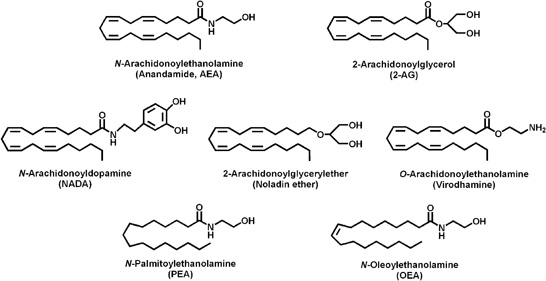What are endocannabinoids anyways?
Endocannabinoids are lipid-based molecules that bind to cannabinoid receptors which are from the G-protein-coupled receptor (GPCR) family. These components make up the endocannabinoid system. Endocannabinoids are made in the the body and activate these receptors. The most common endocannabinoids found in the body are Anandamide (AEA) and 2-arachidonoylglycerol (2-AG). These molecules are fatty-acid based molecules that are derived from arachidonic acid and therefore have similar structures. These molecules activate the CB1 or CB2 receptors. The CB1 receptors are typically found in the brain and can influence behavior, memory, cognition and movement. These receptors modulate adenylyl cyclase and therefore the the intracellular cAMP levels which regulates regulates protein kinase A (PKA) phosphorylation. This causes changes in the cellular activity. The CB2 receptors are predominantly associated with immune cells and modulating the immune system. Activation of these receptors can promote neuro-protection
CB1 receptors are typically found in the brain and can influence behavior, memory, cognition and movement. These receptors modulate adenylyl cyclase and therefore the the intracellular cAMP levels which regulates regulates protein kinase A (PKA) phosphorylation. This causes changes in the cellular activity. The CB2 receptors are predominantly associated with immune cells and modulating the immune system. Activation of these receptors can promote neuro-protection
CBD oil vs. Cannabis
The use of cannabis and cannabidiol oil (CBD oil) to treat various diseases and illnesses is increasing in popularity. However, the differences between the two substances are not very well known. Cannabis is a schedule I drug and is only legal in a few states, whereas CBD oil is legal in all 50 states. THC is the psychoactive component found in cannabis that is not in the CBD oil. The THS is the component that causes the undesirable side effects and produces the ‘high’ feeling. The CBD oil, however, is non-psychoactive and can yield the same benefits of activating the endocannabinoid receptors without the psychoactive component. CBD can help inhibit adenosine re-uptake. This leads to an increase of adenosine in the brain which can help alleviate anxiety symptoms and improve anti-inflammatory effects.

These substances can be used therapeutically to treat anxiety, Parkinson’s Disease and cancer. Anxiety is reduced due to the activation of the CB1 receptors by THC which is known to have relaxing and mood enhancing effects. However regular use of Cannabis has been shown to worsen symptoms of anxiety.
Endocannabinoids can differentiate between healthy cells and cancerous cells when carrying out apoptosis. There are more CB1 receptors in cancerous cells which lead to more endocannabinoids binding and therefore more apoptosis occurring in cancerous cells. By this mechanism, endocannabinoids can help shrink tumors and prevent metastasis.
The endocannabinoid system is also affected in Parkinson’s Disease. The CB1 receptors are predominantly expressed in sensory motor neurons. The loss of dopaminergic neurons in Parkinson’s Disease causes an overactive inhibitory pathway on the motor thalamus which is why motor issues are displayed in Parkinson’s disease. Using agonists for the CB1 receptors here would regulate the neurotransmitter balance in this area and help restore motor function.
There are still lots of unanswered questions…
The main issue faced with the therapeutic use of cannabis or endocannabinoid agonist is that these drugs can be hard to access. Due to the fact that cannabis is a Schedule I drug, it is illegal to have possession of this substance. Since it is so difficult to gain access to this substance- even for research purposes- there still is a lot of research to be done to completely understand the drug and all of its benefits as well as side-effects and drawbacks.